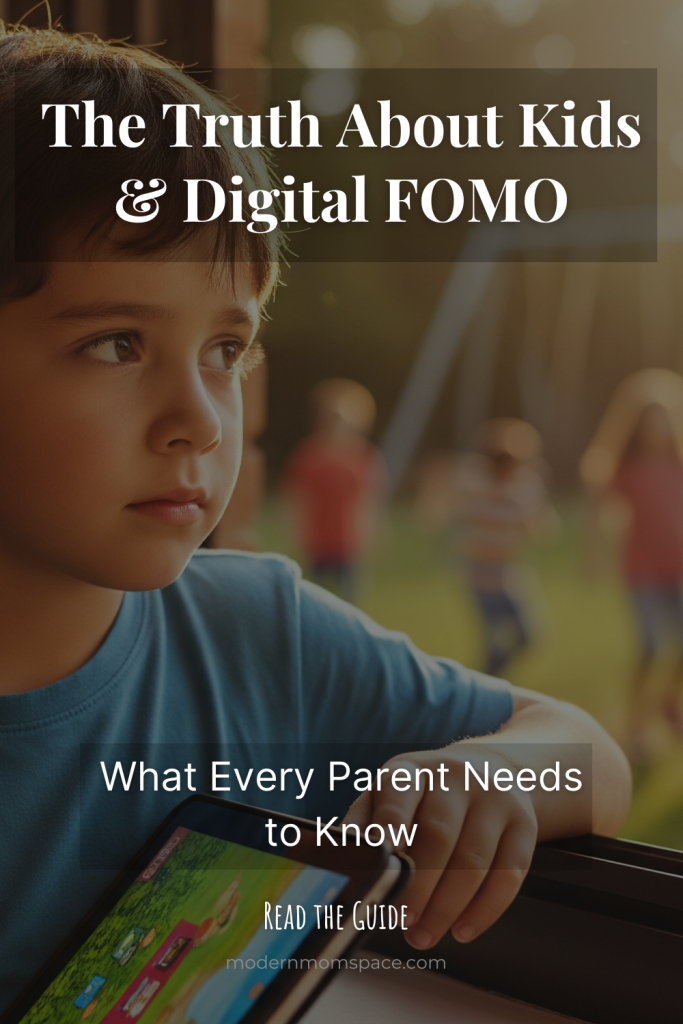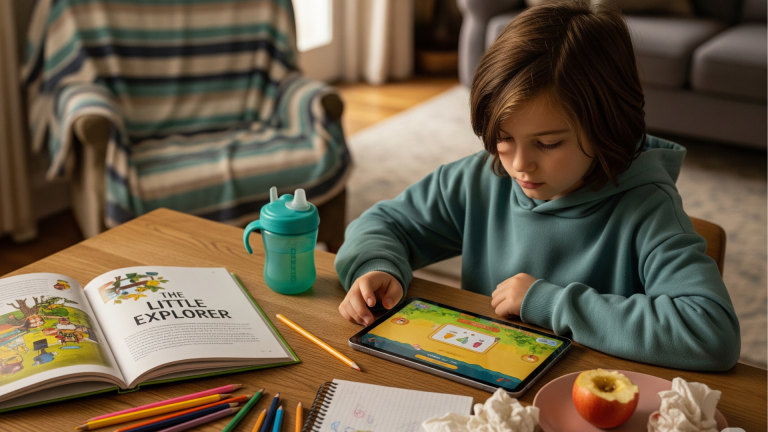FOMO in Kids and Parenting: Symptoms, Examples, and How to Break the Cycle
Kids today are not just missing parties. They are missing sleep, calm, and sometimes confidence. They check phones at midnight. They panic when they see a friend’s post. That panic has a name: FOMO, fear of missing out.
Pause. This is not just teenage drama. It is a real, measurable issue that shapes how children use technology, how they make friends, and how families schedule their lives.
FOMO, short for fear of missing out, is the anxious feeling that others are having rewarding experiences without you. For kids, FOMO shows up as meltdowns and midnight scrolling. For parents, it shows up as guilt, over-scheduling, or the constant urge to keep tabs on every opportunity so their child does not “miss out.” Recognizing FOMO symptoms is the first step toward fixing it.
Below is a practical guide for parents: how FOMO looks by age, why it develops, why kids with attention issues are especially vulnerable, the hidden costs, and clear, usable strategies to break the cycle. I back the core claims with research so you can cite authority and offer parents something that actually helps.
What FOMO Looks Like in Kids
FOMO does not look the same at every age. Its shape changes as kids grow, and that matters for how you respond.
Young kids
Tweens and teens
Common emotional triggers
Behavioral signs to watch for
Concrete FOMO symptom examples parents will recognize
This is not rare. Studies vary, but several large surveys and reviews show a significant portion of young people report FOMO and that it affects mood, sleep, and self-esteem. One review and several studies link FoMO to increased social media use and to problematic patterns of online behavior. (SAGE Journals)
Why Kids Develop FOMO
Let’s be direct. FOMO is not a personality flaw. It is a predictable consequence of three things colliding: human social wiring, modern tech, and adult behavior.
Belonging is a core developmental need
Humans evolved to live in groups. Children are wired to seek inclusion. That drive peaks during adolescence when peer approval becomes central to identity. In other words, wanting to belong is normal and useful—until tech supercharges it.
Comparison culture amplifies the problem
Social media is a highlight reel, intentionally edited and often curated. Kids watch short, endless demonstrations of other people’s best moments. The brain sees “others rewarded” and responds with urgency: check again, respond faster, don’t miss out. That loop fuels FOMO. Evidence shows FOMO predicts more frequent and broader social media use, and that this can move into problematic use for some kids.
Parental cues matter
If parents act like missing a single tournament or class is catastrophic, kids internalize that. Overscheduling kids, or talking about “opportunities” as if attendance equals future success, increases pressure. Children pick up on this. Modeling matters. If you panic about missing an event, your child learns to panic too.
Overscheduling and the “keep up” economy
Many families run a calendar that looks like a sports roster. When every potential activity is framed as essential, kids feel like saying no equals falling behind socially and academically. That pressure is fertile ground for FOMO.
Quick reference: a large teen-focused study and several reviews found that FOMO is linked to both heavier social media use and problematic patterns such as compulsive checking. That means FOMO is not only emotional; it drives behavior that can be harmful. (PMC)
FOMO and How It Might Affect Children with Attention Issues
This section matters. ADHD or significant attention challenges change the rules.
Short answer: kids with attention issues are more vulnerable to FOMO. Here is why.
Impulse control is harder
Kids with ADHD struggle with impulse control. That makes stepping away from a buzzing phone or a live game harder. The “just one more” trap is stronger. When a notification pings, impulse wins. That drives repetitive checking and makes the FOMO loop harder to break.
Hyperfocus and the pull of social feeds
ADHD brains can flip into hyperfocus. When the stimulus is socially rewarding—likes, direct messages, live gaming—hyperfocus locks in and then it is brutal to disengage. This intensifies sleep loss and distractibility.
Emotional reactivity and rejection sensitivity
Many kids with ADHD show higher sensitivity to rejection or perceived exclusion. Academic studies indicate increased rejection sensitivity and anxious reactivity in children with attention symptoms. That emotional profile makes exclusion feel catastrophic, and FOMO hits harder. (additudemag.com)
Transition problems are amplified
Children with attention issues often struggle when routines change. Missing an event or being excluded is a transition they cannot easily manage. That can cause rages, prolonged meltdowns, or shutdowns instead of the short-lived disappointment a neurotypical child might show.
Real example
Imagine a 10-year-old with ADHD who is not invited to a weekend gaming session. They might:
This is predictable. It is not willful. It needs clear boundaries, short coping tools, and routines that reduce sudden transitions.
Data point
Research notes ADHD-related attention differences make kids more prone to distraction and emotional sensitivity, which means FOMO cycles are more entrenched and require extra structure and coaching.
The Parent Side of FOMO
Parents feel FOMO too. This matters more than you think.
Three common parent reactions
- Fear of falling behind – Many parents sign kids up for every activity to avoid the risk their child will miss a “critical opportunity.”
- Parental guilt – Saying no triggers guilt. “Maybe they’ll miss a social chance” becomes a constant whisper.
- Digital habits – Parents checking work, messages, and kids’ group updates model a behavior: constant connection is urgent. Kids mimic this.
The feedback loop
Parental FOMO creates the environment where children feel they must say yes to every invitation. Over time the household normalizes being always-on. That sends a clear message: missing out is not acceptable.
A revealing stat
Research on young adults shows high levels of FOMO among that group, implying that many parents may have grown up or live with the same anxieties they now project onto their children. One study suggested roughly three quarters of young adults experience FOMO in some form. That’s an important point: adults pass this on.
Practical takeaway
If you want a child who can handle not being invited, you must model calm. If you panic when an opportunity arises or fades, your kid will too.
The Hidden Cost of FOMO
This is where the math hits home. FOMO has concrete costs in time, mental health, and relationships.
Burnout on the calendar
Kids who say yes to everything burn out. That looks like emotional exhaustion, reduced enjoyment, and poorer performance academically and socially. Overscheduling combined with FOMO is a fast track to stress.
Shallow friendships
Chasing invitations can produce quantity at the expense of quality. When social life is a checklist, relationships stay surface-level. Deep friendships need time, shared struggle, and unstructured interaction—things FOMO-driven schedules often eliminate.
Anxiety, poor sleep, and lower resilience
FOMO-related phone use often happens late at night. That reduces sleep. Reduced sleep worsens mood and attention. Several studies link these patterns to increased anxiety and diminished life satisfaction. Reviews and surveys report a range of worrying patterns: some studies report that up to a third of young people show problematic social media use, and others find a sizable minority at risk of addictive patterns around platforms. (SAGE Journals)
The addiction angle
“Addiction” is a loaded word, but researchers consistently flag that compulsive social media behavior is a real risk. Recent longitudinal research shows teens who develop compulsive patterns of device use are more likely to experience serious mental health issues. This is not just screen time; it’s how the tech captures and reinforces attention.
How Parents Can Help Kids Handle FOMO
This is the practical section. No theory. Real moves you can implement this week.
Before you start: set the headline goal
Your target is not to eliminate FOMO. That is impossible. Your job is to reduce its power—so FOMO does not control sleep, schoolwork, friendships, or family time.
1. Normalize downtime
When your child whines about missing something, pause. Then say, “Missing one thing does not erase you.” Repeat as needed.
2. Reframe “everyone else” thinking
3. Model missing out calmly
4. Build confidence in individual choices
5. Manage digital influence
6. Prioritize depth over breadth
7. Extra support for attention issues
Practical scripts you can use right now
Evidence-based anchor
A number of studies link FOMO to heavier social media use and to problematic online behavior. That means limiting compulsive checking and teaching perspective are not just feel-good advice; they reduce the behavior that fuels FOMO.
When FOMO Becomes More Serious
Most FOMO is manageable at home. But watch for signs it is crossing into something that needs outside help.
Warning signs
When to get help
Practical referral tips
Conclusion
FOMO is common. It is not a parenting failure. It is a predictable response to social wiring, always-on technology, and the pressure to keep up. For many kids, and especially for those with attention issues, FOMO leads to compulsive checking, anxiety, and poor sleep. That makes it a real parenting issue you should treat with a plan.
Practical takeaway
You do not have to eliminate FOMO. You only need to make it less powerful. Start small, be consistent, and focus on sleep, routine, and stronger friendships. Those changes will make more difference than trying to win the FOMO race.
Keep Exploring
If you want to dig deeper into related topics, these existing guides on Modern Mom Space complement the points covered here:








